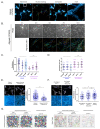Extracellular matrix anisotropy is determined by TFAP2C-dependent regulation of cell collisions
- PMID: 31659294
- PMCID: PMC6989216
- DOI: 10.1038/s41563-019-0504-3
Extracellular matrix anisotropy is determined by TFAP2C-dependent regulation of cell collisions
Abstract
The isotropic or anisotropic organization of biological extracellular matrices has important consequences for tissue function. We study emergent anisotropy using fibroblasts that generate varying degrees of matrix alignment from uniform starting conditions. This reveals that the early migratory paths of fibroblasts are correlated with subsequent matrix organization. Combined experimentation and adaptation of Vicsek modelling demonstrates that the reorientation of cells relative to each other following collision plays a role in generating matrix anisotropy. We term this behaviour 'cell collision guidance'. The transcription factor TFAP2C regulates cell collision guidance in part by controlling the expression of RND3. RND3 localizes to cell-cell collision zones where it downregulates actomyosin activity. Cell collision guidance fails without this mechanism in place, leading to isotropic matrix generation. The cross-referencing of alignment and TFAP2C gene expression signatures against existing datasets enables the identification and validation of several classes of pharmacological agents that disrupt matrix anisotropy.
Conflict of interest statement
There are no competing financial interests to declare.
Figures






References
Publication types
MeSH terms
Substances
Grants and funding
LinkOut - more resources
Full Text Sources
Other Literature Sources
Molecular Biology Databases
Research Materials

